Intercostal retractions - Study guides, Class notes & Summaries
Looking for the best study guides, study notes and summaries about Intercostal retractions? On this page you'll find 2611 study documents about Intercostal retractions.
Page 4 out of 2.611 results
Sort by
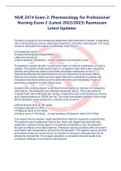
-
NUR 2474 Exam 2: Pharmacology for Professional Nursing Exam 2 (Latest 2022/2023) Rasmussen Latest Updates. A patient is brought to the emergency department with shortness of breath, a respiratory rate of 30 breaths per minute, intercostal retractions, a
- Exam (elaborations) • 34 pages • 2023
- Available in package deal
-
 teachme2expert
teachme2expert
-
- $12.49
- + learn more
NUR 2474 Exam 2: Pharmacology for Professional Nursing Exam 2 (Latest 2022/2023) Rasmussen Latest Updates. A patient is brought to the emergency department with shortness of breath, a respiratory rate of 30 breaths per minute, intercostal retractions, and frothy, pink sputum. The nurse caring for this patient will expect to administer which drug
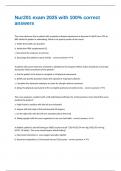
-
Nur201 exam 2025 with 100% correct answers
- Exam (elaborations) • 34 pages • 2025
-
 QUILLSKY
QUILLSKY
-
- $14.99
- + learn more
The nurse observes that a patient with respiratory disease experiences a decrease in SpO2 from 93% to 88% while the patient is ambulating. What is the priority action of the nurse? a. Notify the health care provider. b. Administer PRN supplemental O2. c. Document the response to exercise. d. Encourage the patient to pace activity. - correct answers b A patient with acute shortness of breath is admitted to the hospital. Which action should the nurse take during the initial assessment of th...
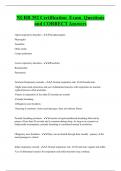
-
NURB 352 Certification Exam Questions and CORRECT Answers
- Exam (elaborations) • 36 pages • 2024
- Available in package deal
-
 MGRADES
MGRADES
-
- $9.49
- + learn more
Upper respiratory disorders - Nasopharyngitis Pharyngitis Tonsillitis Otitis media Croup syndromes Lower respiratory disorders - Bronchitis Bronchiolitis Pneumonia Newborn Respiratory normals - -Normal respiration rate: 30-60 breaths/min. -Slight intercostal retractions and use of abdominal muscles with respiration are normal; xyphoid process often protrudes. -Pauses in respiration of less than 20 seconds are normal -Periodic breathing -Obligatory nose breathers
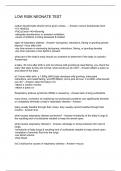
-
LOW RISK NEONATE TEST
- Exam (elaborations) • 15 pages • 2024
-
 Greaterheights
Greaterheights
-
- $12.49
- + learn more
<15-16mEq/L -PaCo2 level <40-45mmHg -adequate spontaneous or assisted ventilation -cause of acidosis is being assessed & treated signs of respiratory distress - Answer--tachypnea, retractions, flaring or grunting persist beyond 1 hour after birth -any time severe or worsening tachypnea, retractions, flaring, or grunting develop -any time cyanosis or low SpO2 is present what part of the baby's body should you examine to determine if the baby is cyanotic - Answer-lips a baby, ...
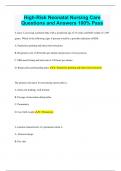
-
High-Risk Neonatal Nursing Care Questions and Answers 100% Pass
- Exam (elaborations) • 46 pages • 2024
- Available in package deal
-
 BrilliantScores
BrilliantScores
-
- $11.99
- + learn more
High-Risk Neonatal Nursing Care Questions and Answers 100% Pass A nurse is assessing a preterm baby with a gestational age of 32 weeks and birth weight of 1,389 grams. Which of the following signs if present would be a possible indication of RDS. A. Expiratory grunting and intercostal retractions. B. Respiratory rate of 46 breaths per minute and presence of acrocyanosis. C. Mild nasal flaring and heart rate of 140 beats per minute. D. Bradycardia and bounding pulse A. Expiratory gruntin...
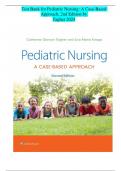
-
TEST BANK for Pediatric Nursing: A Case-Based Approach (2ND Edition) by Tagher A+ LATEST GUIDE 2024
- Exam (elaborations) • 302 pages • 2024
- Available in package deal
-
 PureGold
PureGold
-
- $23.99
- + learn more
Pediatric Nursing: A Case-Based Approach 2nd Edition by Catherine Gannon Tagher test bank Stuvia Is Available For Download After Purchase. In Case You Encounter Any Difficulties Downloading Test Bank for Pediatric Nursing Tagher, Please Feel Free To Reach Out To Me. I Will Promptly Send It To You Through Google Doc or Email. Thank You. 1. A nurse is providing care for a 4-month-old infant at the pediatric clinic. During the assessment the nurse should expect that the infant has reached which...
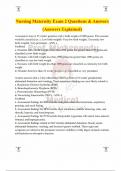
-
Nursing Maternity Exam 2 Questions & Answers (Answers Explained)
- Exam (elaborations) • 48 pages • 2024
-
 ProfMiaKennedy
ProfMiaKennedy
-
- $14.64
- + learn more
Nursing Maternity Exam 2 Questions & Answers (Answers Explained)-A neonate is born at 33 weeks' gestation with a birth weight of 2400 grams. This neonate would be classified as: a. Low birth weightb. Very low birth weightc. Extremely low birth weightd. Very premature - ANS: a Feedback a. Neonates with a birth weight of less than 2500 grams but greater than 1500 grams are classified as low birth weight. b. Neonates with birth weight less than 1500 grams but greater than 1000 grams are clas...
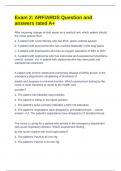
-
Exam 2: ARF/ARDS Question and answers rated A+
- Exam (elaborations) • 8 pages • 2025
- Available in package deal
-
 flyhigher329
flyhigher329
-
- $14.49
- + learn more
Exam 2: ARF/ARDS Question and answers rated A+ After receiving change-of-shift report on a medical unit, which patient should the nurse assess first? a. A patient with cystic fibrosis who has thick, green-colored sputum b. A patient with pneumonia who has crackles bilaterally in the lung bases c. A patient with emphysema who has an oxygen saturation of 90% to 92% d. A patient with septicemia who has intercostal and suprasternal retractions - correct answer d. A patient with septicemia w...
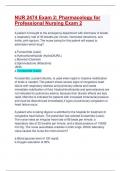
-
NUR 2474 Exam 2: Pharmacology for Professional Nursing Exam 2: Latest Updated: Guaranteed A+ Score Guide
- Exam (elaborations) • 51 pages • 2024
- Available in package deal
-
 Joy100
Joy100
-
- $7.99
- + learn more
A patient is brought to the emergency department with shortness of breath, a respiratory rate of 30 breaths per minute, intercostal retractions, and frothy, pink sputum. The nurse caring for this patient will expect to administer which drug? a.Furosemide (Lasix) b.Hydrochlorothiazide (HydroDIURIL) c.Mannitol (Osmitrol) d.Spironolactone (Aldactone) (ANS- a.Furosemide (Lasix) Furosemide, a potent diuretic, is used when rapid or massive mobilization of fluids is needed. This patient sho...
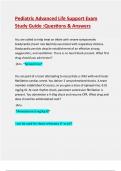
-
Pediatric Advanced Life Support Exam Study Guide :Questions & Answers: Latest Updated A+ Guide Solution
- Exam (elaborations) • 43 pages • 2024
-
 Joy100
Joy100
-
- $8.00
- + learn more
You are called to help treat an infant with severe symptomatic bradycardia (heart rate 66/min) associated with respiratory distress. Bradycardia persists despite establishment of an effective airway, oxygenation, and ventilation. There is no heart block present. What first drug should you administer? (Ans- *Epinephrine* You are part of a team attempting to resuscitate a child with ventricular fibrillation cardiac arrest. You deliver 2 unsynchronized shocks. A team member established IO acce...

$6.50 for your textbook summary multiplied by 100 fellow students... Do the math: that's a lot of money! Don't be a thief of your own wallet and start uploading yours now. Discover all about earning on Stuvia


